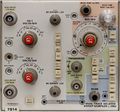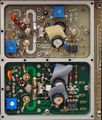7S14: Difference between revisions
mNo edit summary |
No edit summary |
||
| (34 intermediate revisions by 5 users not shown) | |||
| Line 1: | Line 1: | ||
7S14 is a | {{Plugin Sidebar | ||
It is a complete sampling system unlike, for example, the [[ | |manufacturer=Tektronix | ||
which requires a separate timing plug-in to provide triggering | |series=7000-series scopes | ||
and sampling pulse generation. | |type=7S14 | ||
The 7S14 contains two samplers, trigger and sweep circuitry, | |summary=1 GHz dual-trace, delayed-sweep sampler | ||
|image=Tek-7s14-front.jpg | |||
|caption=7S14 front | |||
|introduced=1974 | |||
|discontinued=1988 | |||
|manuals= | |||
* [[Media:070-1410-00.pdf|Tektronix 7S14 Instruction Manual]] | |||
** [[Media:070-1410-00 (2).pdf|Alternate]] | |||
}} | |||
The '''Tektronix 7S14''' is a 1 GHz dual-trace delayed sweep sampler plug-in. | |||
It is almost identical to the [[5S14]] plugin for the [[5000-series_scopes|5000 series]]. | |||
It is a complete sampling system unlike, for example, the [[7S11]], which requires a separate timing plug-in to provide triggering and sampling pulse generation. | |||
{{BeginSpecs}} | |||
{{Spec| Rise time | 350 ps (1 GHz bandwidth) }} | |||
{{Spec| Trigger bandwidth | 100 MHz (Norm/Auto trigger), 1 GHz (HF sync) }} | |||
{{Spec| Vertical deflection | 2 mV/Div to 0.5 V/Div in 1−2−5 sequence }} | |||
{{Spec| Sweep rate | 100 µs/Div to 100 ps/Div in 1−2−5 sequence }} | |||
{{Spec| Input impedance | 50 Ω }} | |||
{{Spec| Maximum input | 5 V peak }} | |||
{{Spec| Features | | |||
* Dual channel, CH1 / CH2 / Dual / Add / X−Y modes | |||
* Delayed timebase | |||
* DC Offset controls | |||
}} | |||
{{EndSpecs}} | |||
==Internals== | |||
The 7S14 contains two samplers, trigger and sweep circuitry, | |||
and circuitry to interface it with the 7000-series mainframe in which it operates. | and circuitry to interface it with the 7000-series mainframe in which it operates. | ||
The mainframe provides the 7S14 with power. | The mainframe provides the 7S14 with power. | ||
The 7S14 sends the mainframe horizontal, vertical and readout signals. | The 7S14 sends the mainframe horizontal, vertical and readout signals. | ||
The 7S14 has an integrated delay measurement function. | |||
The 7S14 has two triggering modes: triggered and HF-sync. | |||
In triggered mode, the signal passes through two stages of [[MC1672]] ECL logic gate, and then into the [[155-0109]] trigger chip. | |||
In HF-sync mode, the 7S14 uses a [[BD4]] back diode (0.1 mA, 3 pF), and inductor, and a [[152-0177-00]] tunnel diode (10 mA, 4 pF) | |||
to form an oscillator that oscillates somewhere between 16.5 MHz and 25 MHz. | |||
The sampler used by the 7S14 is a two-diode design. Each of the two input channels has its own sampler. | |||
The sampling diodes are in CR1A and CR1B of dual diode [[152-0572-00]]. | |||
The 7S14 has | Most boards in the 7S14 and [[5S14N]] are common. However, since [[5000-series plug-ins]] are shorter than 7000 series and the [[interfaces|mainframe interface]] is different, | ||
the 7S14 contains two 7000-specific interface boards (horizontal/vertical) that plug into the 7000 series mainframe. | |||
The common main horizontal board has the 5000-series interface connector fingers at the rear, these remain hidden within the 7S14 ([[Media:Tek-7s14-right.jpg |see photo]]). | |||
==Repair issues== | |||
There are two 1.35 V mercury button cells, BT1 and BT2, in each of the sampler circuits. | |||
They act as floating bias sources, so if a 7S14 stops working it may be not defective, just the batteries are likely to be dead. | |||
First check the voltage on the cells. The original mercury cells can be replaced with other (less toxic) methods of bias voltage generation. | |||
Two obvious solutions are photovoltaic cells or modern batteries. | |||
The issue has been discussed extensively on the groups.io (formerly Yahoo) TekScopes forum, so search the archives | |||
there for more information. Notably, Ed Breya posted [[7S14/Repairs|detailed notes on the 7S14 bias cell issue]]. | |||
==Links== | |||
* | * [https://www.amplifier.cd/Test_Equipment/Tektronix/Tektronix_7000_series_special/sampler_7S14.htm Tek 7S14 @ amplifier.cd] | ||
* | * [http://www.barrytech.com/tektronix/tek7000/tek7s14.html Tek 7S14 @ barrytech.com] | ||
==Prices== | |||
{| class="wikitable" | |||
|- | |||
In | ! Year | ||
! 1974 | |||
! 1980 | |||
! 1988 | |||
|- | |||
! Catalog price | |||
|align=right| $1,850 | |||
|align=right| $3,200 | |||
|align=right| $6,490 | |||
|- | |||
! In 2023 Dollars | |||
|align=right| $11,400 | |||
|align=right| $11,800 | |||
|align=right| $16,700 | |||
|- | |||
|} | |||
According to an [[Media:Tek Schottky Diodes Memo rot.pdf|internal memo]], in 1979 annual sales were estimated at 98 units. | |||
==Pictures== | |||
<gallery> | <gallery> | ||
Tek-7s14-front.jpg | 7S14 front panel | |||
Tek 7s14 trace1.jpg | |||
Tek 7s14 trace2.jpg | |||
Tek 7s14 trace3.jpg | |||
Tek-7s14-left.jpg | Left side | |||
Tek-7s14-right.jpg | Right side | |||
Tek-7s14-sampler.jpg | Sampler boards detail with cover removed | |||
Tek-7s14-trig-detail.jpg | Trigger board detail - tunnel diode oscillator (CR220, CR221, L220) | |||
7s14 samp.png | Sampler schematic | |||
7s14 trig2.png | Trigger schematic | |||
modified_sampler_with_head-to-head_leds.jpeg | Modified sampler with head-to-head leds | |||
Tek 7s14 rear.jpg | |||
</gallery> | </gallery> | ||
==Components== | |||
{{Parts|7S14}} | |||
[[Category:7000 series combined plugins]] | |||
[[Category:7000 series sampling plugins]] | |||
Latest revision as of 03:54, 25 October 2023
The Tektronix 7S14 is a 1 GHz dual-trace delayed sweep sampler plug-in. It is almost identical to the 5S14 plugin for the 5000 series.
It is a complete sampling system unlike, for example, the 7S11, which requires a separate timing plug-in to provide triggering and sampling pulse generation.
Key Specifications
| Rise time | 350 ps (1 GHz bandwidth) |
|---|---|
| Trigger bandwidth | 100 MHz (Norm/Auto trigger), 1 GHz (HF sync) |
| Vertical deflection | 2 mV/Div to 0.5 V/Div in 1−2−5 sequence |
| Sweep rate | 100 µs/Div to 100 ps/Div in 1−2−5 sequence |
| Input impedance | 50 Ω |
| Maximum input | 5 V peak |
| Features |
|
Internals
The 7S14 contains two samplers, trigger and sweep circuitry, and circuitry to interface it with the 7000-series mainframe in which it operates. The mainframe provides the 7S14 with power. The 7S14 sends the mainframe horizontal, vertical and readout signals.
The 7S14 has an integrated delay measurement function.
The 7S14 has two triggering modes: triggered and HF-sync. In triggered mode, the signal passes through two stages of MC1672 ECL logic gate, and then into the 155-0109 trigger chip. In HF-sync mode, the 7S14 uses a BD4 back diode (0.1 mA, 3 pF), and inductor, and a 152-0177-00 tunnel diode (10 mA, 4 pF) to form an oscillator that oscillates somewhere between 16.5 MHz and 25 MHz.
The sampler used by the 7S14 is a two-diode design. Each of the two input channels has its own sampler. The sampling diodes are in CR1A and CR1B of dual diode 152-0572-00.
Most boards in the 7S14 and 5S14N are common. However, since 5000-series plug-ins are shorter than 7000 series and the mainframe interface is different, the 7S14 contains two 7000-specific interface boards (horizontal/vertical) that plug into the 7000 series mainframe. The common main horizontal board has the 5000-series interface connector fingers at the rear, these remain hidden within the 7S14 (see photo).
Repair issues
There are two 1.35 V mercury button cells, BT1 and BT2, in each of the sampler circuits. They act as floating bias sources, so if a 7S14 stops working it may be not defective, just the batteries are likely to be dead. First check the voltage on the cells. The original mercury cells can be replaced with other (less toxic) methods of bias voltage generation. Two obvious solutions are photovoltaic cells or modern batteries. The issue has been discussed extensively on the groups.io (formerly Yahoo) TekScopes forum, so search the archives there for more information. Notably, Ed Breya posted detailed notes on the 7S14 bias cell issue.
Links
Prices
| Year | 1974 | 1980 | 1988 |
|---|---|---|---|
| Catalog price | $1,850 | $3,200 | $6,490 |
| In 2023 Dollars | $11,400 | $11,800 | $16,700 |
According to an internal memo, in 1979 annual sales were estimated at 98 units.
Pictures
-
7S14 front panel
-
-
-
-
Left side
-
Right side
-
Sampler boards detail with cover removed
-
Trigger board detail - tunnel diode oscillator (CR220, CR221, L220)
-
Sampler schematic
-
Trigger schematic
-
Modified sampler with head-to-head leds
-










